The project proposed by Elon Musk's SpaceX and the US Air Force to test the delivery of hypersonic missiles from a remote Pacific atoll could harm numerous seabirds nesting in a wildlife sanctuary, according to biologists and experts who have spent over a decade protecting them.
This is not the first time that SpaceX's activities have had a negative impact on protected birds. Last year, the launch of SpaceX's Starship rocket in Boca Chica, Texas, was accompanied by an explosion that destroyed the nests and eggs of shorebirds, leading to legal issues for Musk's company. He even joked that he would refrain from eating omelets for a week to make up for it.
In March, the US Air Force announced it had chosen Johnston Atoll, a US territory in the central Pacific, located nearly 800 miles (1300 km) southwest of Hawaii, as the site for testing the Rocket Cargo Vanguard program, which it is developing with SpaceX.
The project involves test landings of reusable rockets designed to deliver up to 100 tons of cargo to any point on Earth in about 90 minutes. This will be a breakthrough for military logistics, as it will ease the rapid transport of supplies to remote areas.
According to biologists and experts who worked on the 2.6-square-kilometer atoll — designated a US National Wildlife Refuge and part of the Pacific Remote Islands National Marine Monument — the project may be too complex for 14 species of tropical birds on the island.
Approximately one million seabirds use the atoll, home to diverse wildlife, throughout the year, compared to a few thousand in the 1980s. Bird species include red-tailed tropicbirds, red-footed boobies, and large frigatebirds, which have wingspans of up to 2.5 meters (8 feet).
"Any type of aviation that flies over the island will impact that moment," said Hawaii biologist Steven Minamishin, who works in the National Wildlife Refuge System, part of the US Fish and Wildlife Service.
"The biggest problem it will bring is the rocket noise, which will flush the birds from their nests and make them so disturbed and unsettled that they won't be able to return to their nests, resulting in a lost generation," said wildlife biologist Ryan Rush from the University of Texas, who spent nearly a year on Johnston.
The project includes the construction of two landing pads and the re-entry landing of 10 rockets over four years.
The Air Force and SpaceX are preparing an environmental impact assessment of the project in the coming weeks for public review. This assessment is a requirement under the National Environmental Policy Act before the Air Force can begin the project, which they aim to start this year.
In a March Federal Register notice, the Air Force stated that the project would unlikely have a significant environmental impact, but noted it could harm migratory birds.
A US Air Force spokesperson stated they are closely consulting with the Fish and Wildlife Service and the National Oceanic and Atmospheric Administration's National Marine Fisheries Service "to assess the impact and develop necessary measures to avoid, minimize, and/or mitigate any potential environmental impacts."
SpaceX did not immediately respond to a request for comment.
Musk serves as an advisor to President Donald Trump as they work on shrinking and transforming the federal government and eliminating thousands of employees.
"EVERYTHING THAT IS LEFT"
According to biologists interviewed by Reuters, in the Pacific, where uninhabited land is scarce and threatened by rising sea levels, birds rely on Johnston for their nesting and survival.
This makes protecting these birds important, said Desiree Sorenson-Groves, president of the National Wildlife Refuge Association, a nonprofit group working to protect the US National Wildlife Refuge System.
"These small remote oceanic islands — they are all that’s left to them," said Sorenson-Groves. "We've put a lot of money as a country into bringing wildlife back to these places."
Johnston Atoll, closed to visitors, is managed by the Air Force and governed by the US Fish and Wildlife Service. From the late 1950s to 1962, the island was used for nuclear testing, and from 1972 to 1975, it was used for storing chemical munitions, including Agent Orange.
The Air Force completed cleaning up the atoll in 2004, and since then, it has served as a sanctuary for seabirds and migratory shorebirds. Human visits to the island are strictly controlled to avoid disturbing the birds.
The Fish and Wildlife Service led efforts to eradicate yellow crazy ants, an invasive species on the atoll, after it was designated as a refuge, sending crews on six-month rotations starting in 2010 and ending in 2021. Crews brought their clothing in sealed bags, froze and disinfected their equipment, and used separate island footwear to prevent the introduction of new species to the atoll, said Eric Baker, a Fish and Wildlife Service volunteer and wildlife photographer who spent a year on Johnston.
"The main rule was to cause no disturbance or be as unobtrusive as possible," said Baker.
Baker said he is concerned that the SpaceX project will undo years of careful conservation efforts.
"The nests and birds there will just kind of evaporate," Baker said.

